5 Ancient Purposes of Jewelry Before Decoration

Jewelry today is most commonly associated with decoration and personal adornment. However, its origins and uses extend far beyond the aesthetic appeal. From spiritual symbolism to markers of social status, jewelry has served numerous ancient purposes throughout human history. This blog post explores five significant roles that jewelry played in ancient cultures before it became primarily a decorative item:
1. Religious and Spiritual Symbolism

Jewelry has been an integral part of spiritual and religious practices across various civilizations:
- Amurites: One of the earliest cultures to use jewelry, the Amurites wore amulets and charms, believing they would offer protection against evil spirits and bring good fortune.
- Egyptians: Ancient Egyptians adorned themselves with intricate pieces often symbolizing the journey to the afterlife. Scarab beetles, for instance, represented rebirth and the eternal cycle of life. The Ankh, an emblem of eternal life, was commonly used in jewelry to invoke divine blessings.
- Greeks: Greek mythology and religion were reflected in jewelry through symbols like the eagle of Zeus, the owl for Athena, and laurel wreaths for victory.
These examples illustrate how jewelry was not just about beauty but served as a conduit for expressing religious beliefs and connecting with the divine.
2. Social Status and Wealth Display

In many ancient societies, jewelry was a primary indicator of an individual’s wealth, power, and social standing:
- Mayans: Mayan elites adorned themselves with jade, a material so precious it was seen as embodying life energy. Gold was another key material, reserved for the nobility.
- Romans: Roman citizens wore gold chains and rings, with the type of jewelry often denoting one’s place in society. The elite had access to the most luxurious items, like the Bulla, a golden amulet worn by children to ward off evil and ensure good health.
- Celts: Celtic leaders wore torcs, neck rings made of gold, as symbols of leadership and authority. The intricacy and weight of these pieces indicated the status of the wearer.
Jewelry was essentially a wearable form of wealth, allowing individuals to immediately assess each other’s status upon first encounter.
3. Healing and Protective Talismans

Beyond decoration, jewelry served as a form of ancient medicine:
- Neolithic Cultures: Early humans crafted amulets from bones or stones, believing in their healing properties and protective powers against diseases.
- Greeks and Romans: They believed in the power of gems; for instance, amethyst was thought to cure hangovers, while ruby was believed to protect from harm.
- Norse: Vikings used Mjölnir amulets, representing Thor’s hammer, for protection and good health. These were commonly buried with the dead to safeguard their journey to the afterlife.
The use of jewelry as talismans highlighted the belief in the supernatural and its integration into daily life for protection and healing.
4. Currency and Trade

Before coins became widespread, jewelry served as currency or a form of trade:
- Mesopotamia: Cuneiform tablets record transactions where jewelry, often gold, was used as payment for goods and services.
- Aztecs: Gold and other precious materials were shaped into ornaments, making trade easier. These items carried both monetary and cultural value, facilitating economic exchanges.
This use demonstrates how jewelry bridged the gap between a primitive barter system and more sophisticated forms of currency.
5. Marriage and Commitment

In various ancient cultures, jewelry symbolized important life events, particularly marriage:
- Egyptians: Wedding rings and rings for marriage proposals were made from materials like gold, symbolizing eternal love due to their circular shape.
- Greeks: The practice of exchanging rings at weddings was common, with rings often inscribed with messages of love or the names of the couple.
- Romans: The concept of engagement rings became prominent, with the ring symbolizing the commitment and promise of marriage.
Jewelry thus served as a tangible symbol of lifelong partnership, love, and commitment.
📝 Note: These purposes of jewelry are not mutually exclusive; often, one piece could serve multiple roles, depending on the context and culture.
The history of jewelry offers a fascinating insight into how it has evolved from a functional and symbolic tool to an item predominantly focused on decoration. Today, while we may not rely on jewelry for its original purposes, understanding these ancient roles enriches our appreciation for these cherished items.
What is the oldest known jewelry?

+
The oldest known jewelry is the Nassarius shell beads discovered in Morocco, dating back to approximately 75,000 years ago. These beads were likely worn as ornaments or as part of religious rituals.
How did jewelry represent social status in ancient cultures?

+
Jewelry was a clear indicator of wealth, power, and social standing. For example, in Mayan culture, elites wore jade and gold, materials exclusive to the nobility, while in Rome, the type of jewelry signified one’s place in society.
Were there any cultural taboos or restrictions on who could wear jewelry?

+
Yes, many cultures had strict rules regarding jewelry. In Ancient Egypt, only certain priests could wear gold, while in Feudal Japan, only the Samurai were permitted to wear swords and specific types of jewelry.



